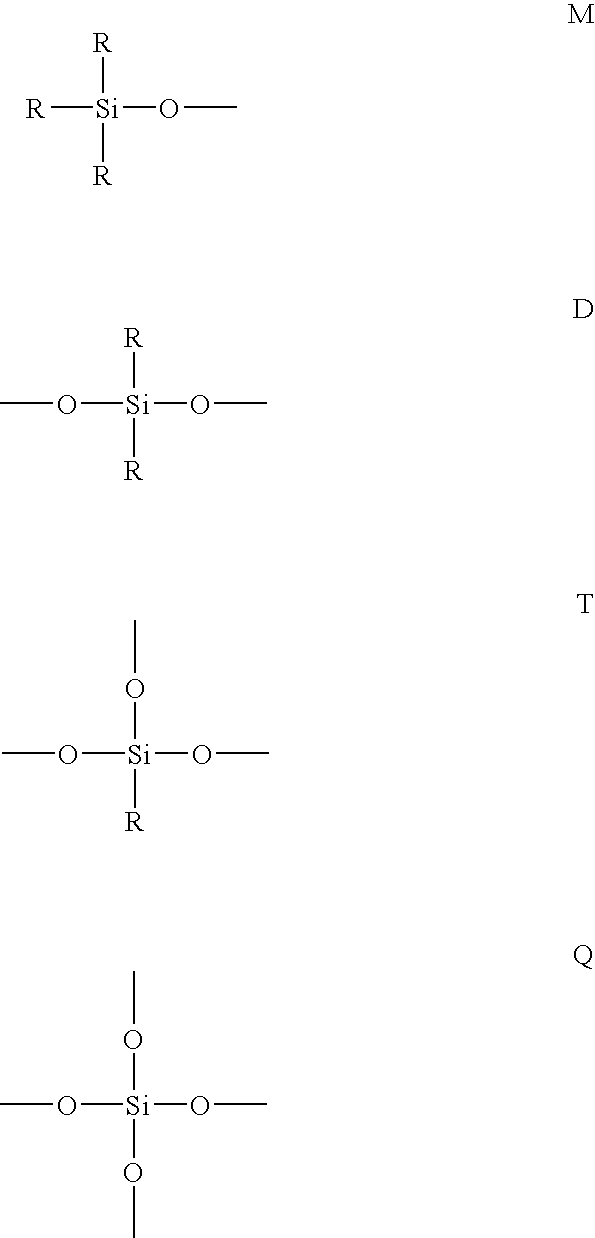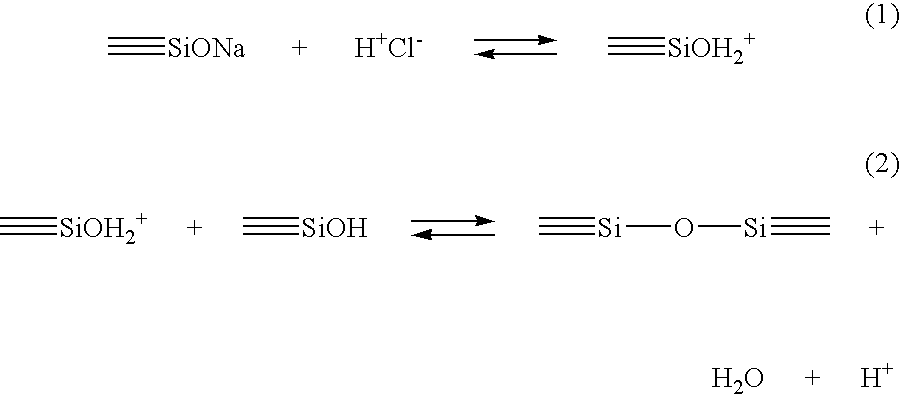Process for preparing a silicone resin
a silicone resin and silicone technology, applied in the field can solve the problems of difficult industrial scale operation, low efficiency, and low efficiency of silicone resin synthesis, and achieve the effect of slowing down the polymerization reaction
- Summary
- Abstract
- Description
- Claims
- Application Information
AI Technical Summary
Benefits of technology
Problems solved by technology
Method used
Image
Examples
example 1
Invention—Preparation of An MQOH Silicone Resin With A Polycondensation Step Carried Out With A Tangential-jet Intensive Mixing Tool
[0101]1-1) An MQOH resin having an M / Q ratio of 0.8 was prepared in a continuous process according to the following description:
[0102]The reaction was carried out, at 20° C., between a sodium silicate at 50% by weight in water (solution A), (SiO2 content of the silicate was 30% by weight and SiO2 / Na2O molar ratio was 3.3), and an aqueous hydrochloric acid solution containing 18% by weight of HCl (solution B) with an SiO2 / HCl molar ratio equal to 0.85. The reaction was carried out in a tangential-jet intensive mixing tool (M) having a dissipated power of 100 kW / m3 and a mixing time t1 of 5 ms (0.005 s), with respective flow rates of solution A and solution B of 40 kg / h and 20 kg / h. The flow of each reactant was divided into two streams which were introduced into the mixer in a diametrically opposed, but slightly offset manner. The injection channels of t...
example 2
Invention—Preparation of An MQOH Silicone Resin With A Polycondensation Step Carried Out With A Tangential-jet Intensive Mixing Tool
[0107]2-1) The operating procedure described in paragraph 1-1) of Example 1 was repeated, then
[0108]2-2) the reaction medium was sent to a perfectly stirred batch-type reactor (R′1) kept at 20° C. The residence time t2 for the polycondensation step in the reactor (R′1) was 3 min.
[0109]2-3) Next, isopropanol (flow rate of 1 kg / h) then the chlorosilanes [(CH3)3SiCl], with a flow rate of 0.6 kg / h were introduced. Xylene was then introduced into this reactor at a flow rate of 0.9 kg / h. The temperature of the reactor was raised to 75° C. over one hour, then kept at this temperature for one hour. The stirring was stopped in order to decant the organic phase containing the resin.
[0110]The organic phase was then devolatilized to obtain the final resin containing 60% of solids in xylene. The final MQOH resin had a viscosity of 10 cpoise at 60% solids and a silan...
example 3
Change In the Weight-average Molecular Weights As A Function of the Concentration of Reactants For the Polycondensation Step
[0111]3-1) A series of tests was carried out under the same conditions as Example 1 but by varying the concentrations of the reactants from step 1-1) (mixing with an intensive tool). The polysilicic acid obtained at the outlet of the intensive mixing tool (M) and of the piston reactor (R1) was characterized by the technique of size-exclusion liquid chromatography (see Table 1 for results). The average weights of the polymer did not vary (or only a little), round 9000 g / l in polystyrene equivalents. At the outlet of the piston reactor R2, the average molecular weights were 1100 g / mol. In the functionalization step, the [(CH3)3SiCl] / [SiO2 from the silicate] ratio was kept constant and was equal to 1.8. The final resins obtained were identical in viscosity and % of silanol. The amounts of xylene were adjusted so as to obtain a final product containing 60% by weigh...
PUM
| Property | Measurement | Unit |
|---|---|---|
| power density | aaaaa | aaaaa |
| residence time t1 | aaaaa | aaaaa |
| residence time t1 | aaaaa | aaaaa |
Abstract
Description
Claims
Application Information
 Login to View More
Login to View More - R&D
- Intellectual Property
- Life Sciences
- Materials
- Tech Scout
- Unparalleled Data Quality
- Higher Quality Content
- 60% Fewer Hallucinations
Browse by: Latest US Patents, China's latest patents, Technical Efficacy Thesaurus, Application Domain, Technology Topic, Popular Technical Reports.
© 2025 PatSnap. All rights reserved.Legal|Privacy policy|Modern Slavery Act Transparency Statement|Sitemap|About US| Contact US: help@patsnap.com


